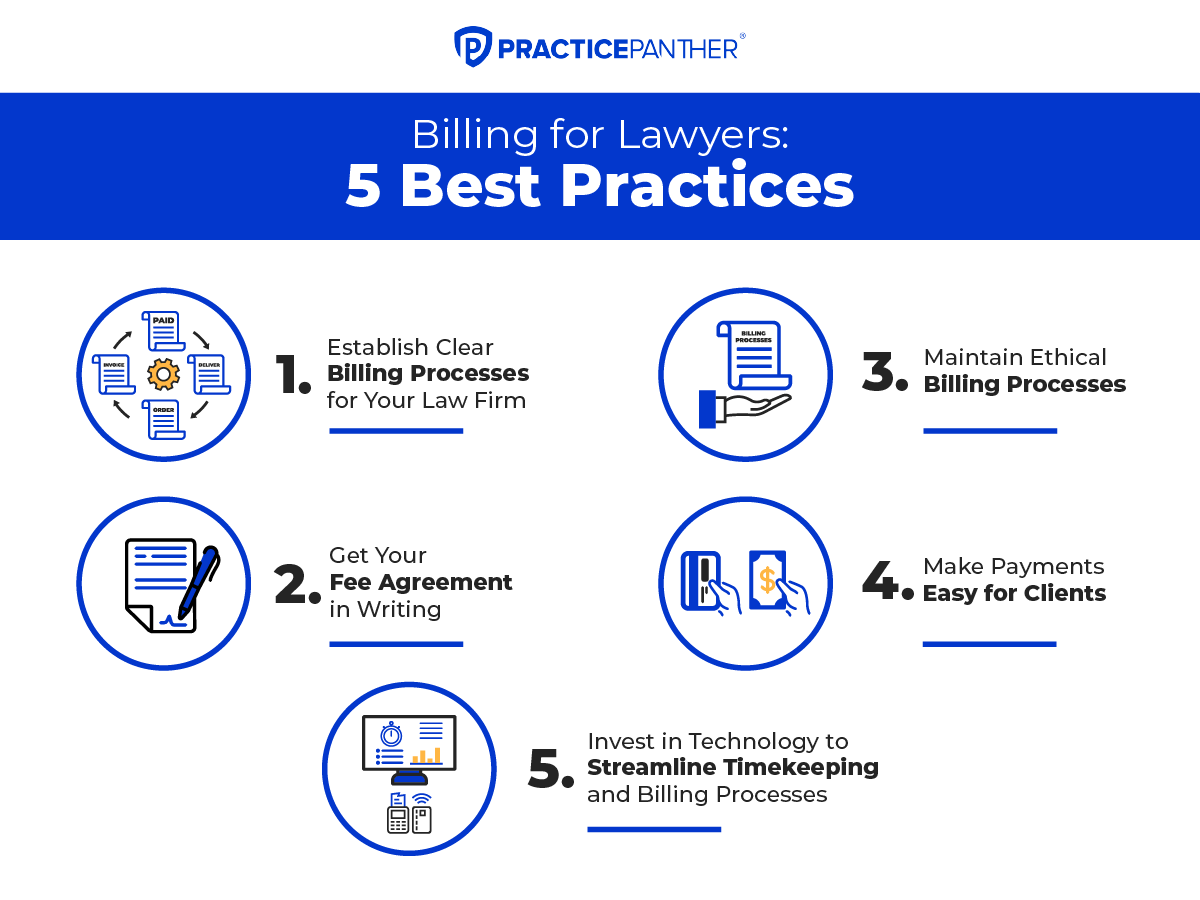


Whether you operate a solo law firm or are an associate in a megafirm, consistency is an essential aspect of billing for lawyers. One of the first actions you should take, even before taking on a new case, is establishing a standard policy for billing clients. You must then implement that policy across the law firm to ensure consistency in billing. When outlining your billing processes, choose a billing method that makes the most sense for your law specialty and firm structure. Think of the number of associates, attorneys, and paralegals that will touch each case from discovery through verdict.
The best billing method for your practice will account for all labor for more consistent and trackable revenue. Many attorneys choose a billing method that seems most accessible or best at the time or ask the personnel they have hired for the financial management of their firm to choose one. While that may seem like the right choice, it is often better to make sure you choose the method for your practice after getting information on the different billing options you can select from. As a practice grows, it is easier to keep the same methods and not have to work through big changes, which is something to keep in mind when you choose your billing method. Standard attorney billing methods include:
With your billing method down pat, you must also determine what client activities are billable. For instance, some firms view administrative tasks or time spent traveling as non-billable hours but will bill for client tasks such as phone calls, writing motions, and meeting with the opposing counsel. Determining what tasks count toward billable and non-billable hours helps to more effectively record client-related tasks and avoid client confusion and billing disputes. This is vital since billing for things a client does not expect to be billed for can sour the client relationship and your law firm’s reputation. You want to be paid fairly for the work you put into the client’s case, but you also want to be sure that your firm is transparent in what is billable and what is not. Putting that information in writing to give to clients at the beginning of your relationship can help reduce misunderstandings.
With a selected billing method and a strong understanding of which client activity is billable versus non-billable, it’s essential to document these details. Drafting your fee agreement, retainer agreement, and representation agreement in writing is critical, as it provides clients with a complete understanding of the work that will be performed and the expenses they will incur. Across every fee agreement, you must explain all terms associated with the attorney-client relationship. These terms include the complete scope of work, from which lawyers or associates will be assigned to the case to the expected legal fees, and how and when the firm will collect these fees.
Providing clients with full written clarification of these fee details at the start of the relationship supports on-time payments and lowers the chance of client disputes. Written clarification is beneficial in the case of contingency fee agreements, which are used across cases like personal injury and workers’ compensation claims. These agreements state the settlement percentage that will be paid to the firm when the case is won, but they also must declare that no fees will be recovered from the client by the firm if the case is lost.
Across the legal industry, professionals are expected to comply with and maintain various operational processes outlined under the ABA Model Rules of Professional Conduct (MRPC). The MRPC expectations include different lawyer billing ethics that law firms are required to maintain to ensure compliant and fair billing practices for every client. So, when navigating attorney billing, it’s vital to review MRPC Rule 1.5 to help maintain ethical processes. This chapter outlines numerous billing expectations regarding the client-lawyer relationship, including charging only reasonable client fees and amounts for expenses. Unethical billing practices, such as marking up your time, double billing, and charging clients for office overhead, can be considered misconduct and place your license and practice at risk.
Naturally, these overbilling issues are not worth any risk to your license, practice, and reputation. Some attorneys will consider doing these things to make extra money, but these are dangerous practices that cause too many problems for law firms that engage in them. It is always better to bill accurately, err on the side of caution, and understand and follow guidelines for proper billing, so there will not be any discrepancies to defend at a later date. Beyond lawyer billing ethics, there are also considerations for how law firms collect payments. This aspect is crucial for law firms that collect online payments, as there are specific compliance requirements for online billing services. Read the following tips to learn how to stay compliant with your online billing, and check our Ethics in Online Payments Guide for more information.
With a complete understanding of fee and billing expectations now accessible to your clients, it’s vital to take streamlined financial management to the next level and simplify how clients make payments. While traditional attorney billing practices typically request payment by check, law firms can now make it easier for clients to pay invoices with internal law practice management software. A reliable law practice management solution provides online payment capabilities that allow clients to pay invoices via various payment types, including Visa, Mastercard, American Express, or even eCheck. Online payment tools also enable unique payment links to be embedded across client communication, like email footers and SMS text messages, for fast and easy client payments. Along with quick payment processing comes accelerated financial data collection. Effective online payment tools can collect payment details and automatically input them into your bookkeeping platform.
Over time, consistent payment data management will help firms better track financial performance and visualize how they stack up against industry benchmarks. While there are several online payment solutions on the market, law firms will be required only to use merchant processors approved by and compliant with the ABA and IOLTA. Rely on a fully compliant system to help avoid audit concerns, especially when conducting trust accounting, which legally requires client funds to be separated from firm finances.
When it comes to billing for lawyers, we understand that aspects like timekeeping and payment collection are complex. Billing processes are tedious, time-consuming, and error-prone tasks that cannot be avoided. However, with the right technology investments, law firms can significantly streamline their billing tasks — and help save time and money where it matters. With the right legal practice management solution, law firms can use real-time expense and time-tracking capabilities to document billable hours and business costs from any device. These tracking solutions feature customizable options that can be adjusted to each attorney’s specific billing rate for accurate invoices every time. Well-organized timekeeping will also benefit the client-attorney relationship, as it supports full billing transparency and builds trust with your clients.
By investing in a law practice management solution, professionals can save significant time on invoice development. Such solutions offer templated invoices that you can quickly populate with exact timekeeping information, including billing rate and hours worked, to help avoid any need for block billing practices. Not to mention, providing such detailed invoices can support faster client payments and reduce the concern of client disputes. Investing in the proper billing and timekeeping solutions can even go as far as helping you better collect client signatures. eSignature capabilities eliminate the need for clients to head into the office to sign off on fee agreements, helping speed up the overall client intake process. By removing these operational roadblocks and better visualizing any outstanding signature needs, attorneys and associates can spend more time on what matters the most, winning the client’s case.
If it seems like billing for lawyers is a multi-part process that requires excellent attention to detail, that’s because it is. But with the proper knowledge, law firms can be better equipped to take on all attorney billing needs. Start by deciding which attorney billing method works best for your practice: hourly rate, flat fee, contingency fee, or retainer billing. Next, draft a formal fee agreement explaining all terms associated with the attorney-client relationship to save yourself from later billing headaches. To avoid compliance concerns, study the various operational processes outlined under ABA MRPC to maintain ethical billing. Then, make billing a breeze with legal billing software that powers online payments, time-tracking abilities, simple invoice development, and even eSignature functionality. From here, you should be ready to bill like a pro. In the final chapter of the PracticePanther Law Firm Finance guide, we will cover the seven essential tax deductions for lawyers to maximize your return.